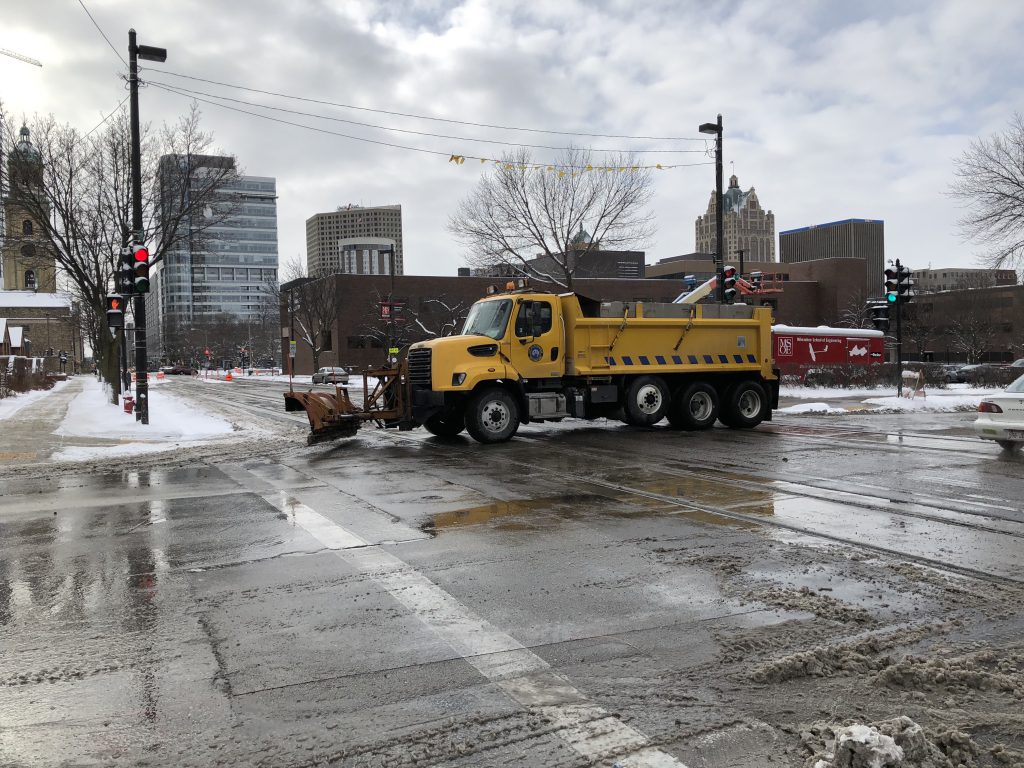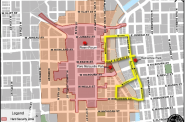DPW Defends Plow Mounting Strategy
Delaying use of plows allowed more salt to be spread and prevented expanding potholes.
Keeping front plows off the city’s more than 100 trucks during the start of a snowstorm was an intentional and successful effort said Department of Public Works (DPW) officials at a Common Council committee meeting Wednesday morning.
During Monday’s snowstorm, DPW sent out the “salters,” dump trucks with salt spreading equipment, without front plows attached until the second shift at approximately 9 a.m. That caused the department to catch flak from a handful of TV stations, including WISN which ran a piece entitled “Rush Hour Plow Problems.”
DPW operations director Laura Daniels defended the choice to the Public Works Committee Wednesday and said it was a strategy based on estimated snow volumes. “There’s some real clear planning that went into that,” said DPW Commissioner Jeff Polenske.
“When we mount that on it means we can only carry half as much salt,” said Daniels. She said during the start of the storm, and in the hours preceding it, the decision was made to use the trucks at their full capacity of 6.8 yards of salt.
A second reason to delay attaching the plows was the presence of underbody scraping plows on the trucks. “It does a fabulous job of scraping the driving lane,” said Daniels.
She said the bigger front plows are used when snow levels exceed two inches. The department began to deploy the trucks with plows attached during an operator shift change during rush hour. At that point 1.9 inches of snow had fallen and the first shift had taken care of salting the streets.
“It was actually the perfect time to mount those blades. It was intentional,” said Daniels.
There is another reason to exercise caution with using the heavy plows. “We’re saving our streets,” said Alderman Mark Borkowski. “When I watch those blades hit the roads, man, the torque, the power. Once you develop a pothole it’s only going to get bigger.”
What About Clearing Snow for Pedestrians?
The committee was satisfied with the rationale for the plowing decision, but questions remain from Ald. Robert Bauman and others on the city’s ability to clear the way for pedestrians.
“There has been a progressive improvement,” said Polenske of DPW’s effort to clear the way for non-motorists.
“We grew up being car centric,” said Daniels. “We are evolving and morphing to be all modes of transportation centric.”
The department has acquired, through contractors and direct purchases, smaller vehicles to clear the more than 60 miles of city-owned sidewalks, protected bike lanes and other rights of way.
She said a full-scale effort to clear crosswalks and bus stops is engaged when more than four inches of snow falls.
“We’re getting a little bureaucratic here,” responded Bauman. “I don’t care what the ordinance says. If that’s your hangup, we’ll change the ordinance.”
Polenske and Daniels said a change in approach to using multiple shifts to clear the sidewalks and other areas would improve things.
“Just clear the snow,” said Bauman.
The downtown and near west side alderman read an excerpt from Invisible Women: Data Bias in a World Designed for Men, a book by Caroline Criado Perez, that detailed how snow removal strategies have an implicit gender bias. The book says that transit riders are more likely to be women, with 64 percent of riders in Philadelphia and 62 percent in Chicago identifying as female, and that clearing the streets for motorists first is biased towards males.
Bauman, a self-identified champion for equality, said he would continue to monitor the issue.
If you think stories like this are important, become a member of Urban Milwaukee and help support real independent journalism. Plus you get some cool added benefits, all detailed here.
Legislation Link - Urban Milwaukee members see direct links to legislation mentioned in this article. Join today
Related Legislation: File 191225























